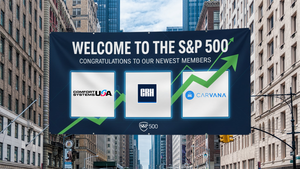
Clothing and footwear retailer Boot Barn (NYSE: BOOT) announced better-than-expected revenue in Q2 CY2025, with sales up 19.1% year on year to $504.1 million. Guidance for next quarter’s revenue was better than expected at $491 million at the midpoint, 1.8% above analysts’ estimates. Its GAAP profit of $1.74 per share was 13.3% above analysts’ consensus estimates.
Is now the time to buy BOOT? Find out in our full research report (it’s free).
Boot Barn (BOOT) Q2 CY2025 Highlights:
- Revenue: $504.1 million vs analyst estimates of $496.4 million (19.1% year-on-year growth, 1.5% beat)
- EPS (GAAP): $1.74 vs analyst estimates of $1.54 (13.3% beat)
- Adjusted EBITDA: $90.61 million vs analyst estimates of $84.42 million (18% margin, 7.3% beat)
- The company lifted its revenue guidance for the full year to $2.14 billion at the midpoint from $2.11 billion, a 1.4% increase
- EPS (GAAP) guidance for the full year is $6.25 at the midpoint, roughly in line with what analysts were expecting
- Operating Margin: 14%, up from 11.9% in the same quarter last year
- Locations: 473 at quarter end, up from 411 in the same quarter last year
- Same-Store Sales rose 9.4% year on year (1.4% in the same quarter last year)
- Market Capitalization: $5.28 billion
StockStory’s Take
Boot Barn’s second quarter results surpassed Wall Street’s expectations, reflecting broad-based momentum across its retail footprint and product categories. Management highlighted that robust same-store sales growth was driven by increased transactions and strength in denim, particularly in women’s. CEO John Hazen credited both new and legacy stores for contributing to sales gains, stating, “New stores are continuing to attract new customers and grow sales after their initial opening.” Merchandise margins also expanded, supported by higher exclusive brand penetration and disciplined inventory management.
Looking forward, Boot Barn’s updated guidance is anchored in ongoing store growth, digital innovation, and a measured approach to pricing amid tariff-related cost pressures. Management pointed to exclusive brand pricing strategies, AI-powered omnichannel enhancements, and continued new store productivity as supporting factors. However, Hazen cautioned, “We remain cautious of overall consumer sentiment and macro uncertainty, and we’ll continue to manage our business prudently.” The company’s approach to holding exclusive brand prices steady while monitoring elasticity will be a key lever as tariff impacts evolve.
Key Insights from Management’s Remarks
Management attributed the strong quarter to successful execution of its four strategic initiatives, especially in expanding exclusive brands and leveraging omnichannel advances.
-
Store network expansion: Boot Barn opened 14 new stores during the quarter, with management noting that recent store cohorts are outperforming older locations. New stores are projected to generate $3.2 million in annual revenue and achieve payback in less than two years, contributing a meaningful tailwind to same-store sales as they mature.
-
Exclusive brands momentum: Penetration of exclusive brands surpassed 40% of sales, up 250 basis points year-over-year. Management focused on marketing investments for proprietary brands like Hawx and Cody James, including new dedicated websites and targeted campaigns, aiming to further boost customer adoption and margin expansion.
-
Category strength in denim: Denim emerged as a standout category, with double-digit growth in both men’s and women’s segments. Broader inventory depth in denim enabled multi-unit purchases and improved customer satisfaction, positioning Boot Barn as a leading jeans destination according to Hazen.
-
Omnichannel and AI innovation: E-commerce comp sales grew 9.3% and the company deployed AI-powered search on its website, in addition to tools for store associates and training modules. Over half of online orders were fulfilled by stores, supporting merchandise margins and driving in-store traffic.
-
Margin management amid tariffs: Merchandise margin rate improved as the company balanced third-party price increases with a “lower-for-longer” pricing strategy for exclusive brands. Management is testing price elasticity before raising exclusive brand prices, seeking to maintain market share while managing tariff-related cost pressures.
Drivers of Future Performance
Boot Barn’s outlook relies on continued store expansion, digital growth, and careful pricing actions in response to tariffs and consumer sentiment.
-
Store growth and productivity: Management expects to maintain a 15% annual increase in store count, with new units delivering strong initial sales and maturing into high-performing locations. The consistent productivity of both new and legacy stores is seen as a major growth driver for the coming year.
-
Exclusive brand pricing strategy: The company is holding off on immediate price increases for exclusive brands to gauge customer response, while third-party brands have already implemented mid-single-digit price hikes. Management believes that this approach will help defend market share and potentially lift exclusive brand penetration further if consumers prioritize value as tariffs take effect.
-
Tariff and consumer risk management: Uncertainty around tariff impacts and broader macroeconomic trends led management to assume flat comparable sales in the back half of the year. The company is prepared to adjust pricing and promotional strategies as needed, closely monitoring demand elasticity and competitive actions.
Catalysts in Upcoming Quarters
In coming quarters, our team will be watching (1) the pace and productivity of new store openings and their contribution to same-store sales, (2) shifts in exclusive brand penetration as the “lower-for-longer” pricing strategy unfolds, and (3) the impact of tariff-related price increases on both demand and merchandise margin. Execution on AI-driven omnichannel initiatives and evolving marketing tactics around denim and workwear will also be important signposts for sustained growth.
Boot Barn currently trades at $173, in line with $171.76 just before the earnings. In the wake of this quarter, is it a buy or sell? The answer lies in our full research report (it’s free).
Now Could Be The Perfect Time To Invest In These Stocks
Trump’s April 2025 tariff bombshell triggered a massive market selloff, but stocks have since staged an impressive recovery, leaving those who panic sold on the sidelines.
Take advantage of the rebound by checking out our Top 6 Stocks for this week. This is a curated list of our High Quality stocks that have generated a market-beating return of 183% over the last five years (as of March 31st 2025).
Stocks that made our list in 2020 include now familiar names such as Nvidia (+1,545% between March 2020 and March 2025) as well as under-the-radar businesses like the once-small-cap company Exlservice (+354% five-year return). Find your next big winner with StockStory today.
StockStory is growing and hiring equity analyst and marketing roles. Are you a 0 to 1 builder passionate about the markets and AI? See the open roles here.



